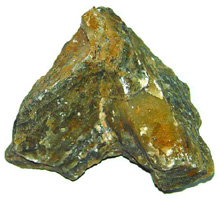Limestone
Limestone a sedimentary rock consisting chiefly of calcium carbonate, primarily in the form of the mineral calcite and with or without magnesium carbonate. Common minor constituents include silica, feldspar, clays, pyrite and siderite. Organic or inorganic processes form limestone. Much limestone is highly fossiliferous and clearly represents ancient shell banks or coral reefs. It is the chief raw material for cement. It is also used in the preparation of paper, steel, sugar, glass and lime.

In Bangladesh there are surface and sub-surface deposits of limestone. The surface to near surface deposits are at st martin's island of Cox's Bazar district and Bhangerghat-Lalghat-Takerghat of Sunamganj district. The subsurface deposit is present at Joypurhat of Joypurhat district. The limestone at the St Martin's Island is Late Pleistocene and the other limestone is of Eocene age.
In Bangladesh the limestone deposit was first discovered at St Martin’s Island in 1957. Later, Geological Survey of Pakistan (GSP) surveyed the area in 1958 and found 1.8 million ton of shelly and coralline limestone in an area of 0.60 sq km. However, these limestones are not of good quality. In the years between 1951 and 1957 small pieces of limestone were found at Takerghat area of Sunamganj district. Later, GSP drilled 66 holes in the area in 1961 to know the extent of the limestone. It was found that the limestone is extended in the Bagalibazar-Takergaht-Bhangerghat area of the district. At Bagalibazar it is 30m to 100m below the surface. The average thickness is 152.2m and reserve is 17 million tons covering an area of 0.77 sq km. In Lalghat the limestone is 6m to 10m below the surface.
The thickness varies from 22m to 76m and the reserve is 9.8 million tons in an area of 0.25 sq km. In Takerghat the limestone is 7m to 57m below the surface. The thickness varies from 2.8m to 44m and reserve is 2.2 million tons in an area of 0.42 sq km and in Bhangerghat the limestone is 29m below the surface. The thickness varies from 6m to 37m and reserve is 1.0 million ton in an area of 0.0013 sq km. In 1982 geological survey of bangladesh (GSB) drilled 5 more holes in the area and expected more deposits of limestone at shallower depth.
Exploitation of limestone from Takerghat area started in 1965 by East Pakistan Industrial Development Corporation when the supply of limestone for Chhatak Cement Factory from Meghalaya stopped due to the Indo-Pak war. About 0.612 million tons of limestone was extracted from the area from 1972 to 1993. At present the reserve is almost replenished. Besides small deposit of limestone (up-thrown block) at the Dauki river of Sylhet district is also present. This deposit is also almost replenished due to extraction by local people.
The deposit of sub-surface limestone was first discovered at a depth of 1967m below the surface at Kuchma of Bogra district when Standard Vacuum Oil Company was drilling for oil. Later, in 1964 GSP (under UNPAK mineral survey project) investigated detail geological and geophysical surveys in the area and found Eocene limestone in the region. Drilling in this area confirmed the limestone at 330m below the surface at Patnitala of Naogaon district, 495m at Paharpur of Joypurhat district and 517m to 548m at Joypurhat-Jamalganj area. In 1966 Fried Krupp Roshtoff of Germany completed the feasibility study of the mining of limestone and found the mine economically feasible. In 1969 Paul Dofrin Technical Service of UK re-evaluated the project and the government took the project for mining. In 1974 Government of Bangladesh approved the exploration of limestone from the depth by shaft sinking employing freezing method.
In 1978 GSB drilled two more holes in the proposed mine area and by analysis of all the data they calculated the reserve of 270 million tons of limestone of which 100 million ton is mineable from an area of 6.7 sq km. Cementation Mining Ltd of UK calculated the underground temperature of the mine area and found that the temperature is little higher than the general depth gradient temperature of the area. They opined that the freezing cost of the mineshaft will be higher and as a result the mine will not be economically feasible. According to their opinion the project for extraction of limestone from Joypurhat area was abandoned. GSB in the years 1996 and 1997 drilled two more holes to get the limestone at shallower depth but these were not successful. [QM Arifur Rahman]
See also mineral resources.
